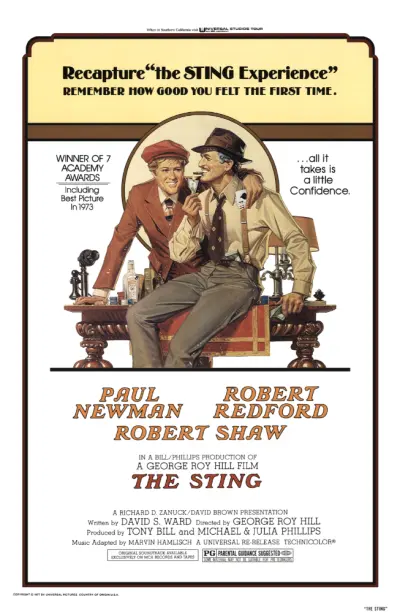
Picture this: a haze of cigarette smoke swirling over shadow-filled rooms with the clink of whisky glasses. Now, that's the setting of 'The Sting', a film that's as much of a clever ruse as the cons played out by its charming protagonists. Directed by George Roy Hill, this 1973 cinematic gem spins the tale of two professional grifters, Johnny Hooker (played by Robert Redford) and Henry Gondorff (played by Paul Newman), who embark on a mission to pull off the ultimate con on a mob boss named Doyle Lonnegan (played by Robert Shaw). The movie is a delightful dance of deception, set against the backdrop of 1930s Chicago, where jazz is hot, the stakes are high, and trust is as scarce as an honest man.
The narrative of 'The Sting' is a meticulously constructed con-within-a-con, deftly layering twist after twist. Hooker and Gondorff concoct an elaborate scenario, involving a sham betting parlor and a host of colorful accomplices, to ensnare their mark, Lonnegan. But the scenario's meaning goes beyond the surface of its plot, touching upon the idea that even in the world of grifters, there's a certain honor among thieves—a silent code that determines who gets to be on the giving or receiving end of a scam.
One thing the film masterfully explores is the themes of friendship, loyalty, and revenge. Hooker is motivated by the desire for vengeance for the death of his partner, who was killed by Lonnegan's men. Meanwhile, Gondorff is pulled back into the grifting game after a falling out from grace. Their camaraderie becomes the foundation for their plan, as important as the intricate scam itself, showcasing that at the core of every great con—and perhaps this film—is a story of unwavering solidarity.
The thematic crux of 'The Sting' is encapsulated in its exploration of illusion versus reality. The film itself is a meta-reflection on this theme, proving that what the audience perceives is as controllable as the mark's perspective in a con. It's not just about fooling Lonnegan; it's about how the filmmakers skillfully guide the audience alongside him, with every revealed twist just another sleight of hand in a grand cinematic illusion.
Style-wise, the movie is a nostalgic nod to the golden age of Hollywood, with its Art Deco sets, stylish costume designs, and Scott Joplin's ragtime music, most notably 'The Entertainer,' seamlessly knitting the scenes together into a coherent period piece. The film's aesthetic choices not only recreate an era but also serve the story, enhancing the illusion and immersing the audience fully into the world of the con artists.
In essence, 'The Sting' captures a bygone era of filmmaking magic and narrative intricacy. It is a well-tailored suit of a story, woven with threads of loyalty, vengeance, and deception. With a legacy that outswindled the test of time, this movie isn't just a stunning piece of entertainment; it's a testament to storytelling as the ultimate con, where the audience willingly allows themselves to be duped for the thrill of the reveal. So here's to Hooker, Gondorff, and their perfect sting: may their grift never lose its charm, nor its clever bite.

